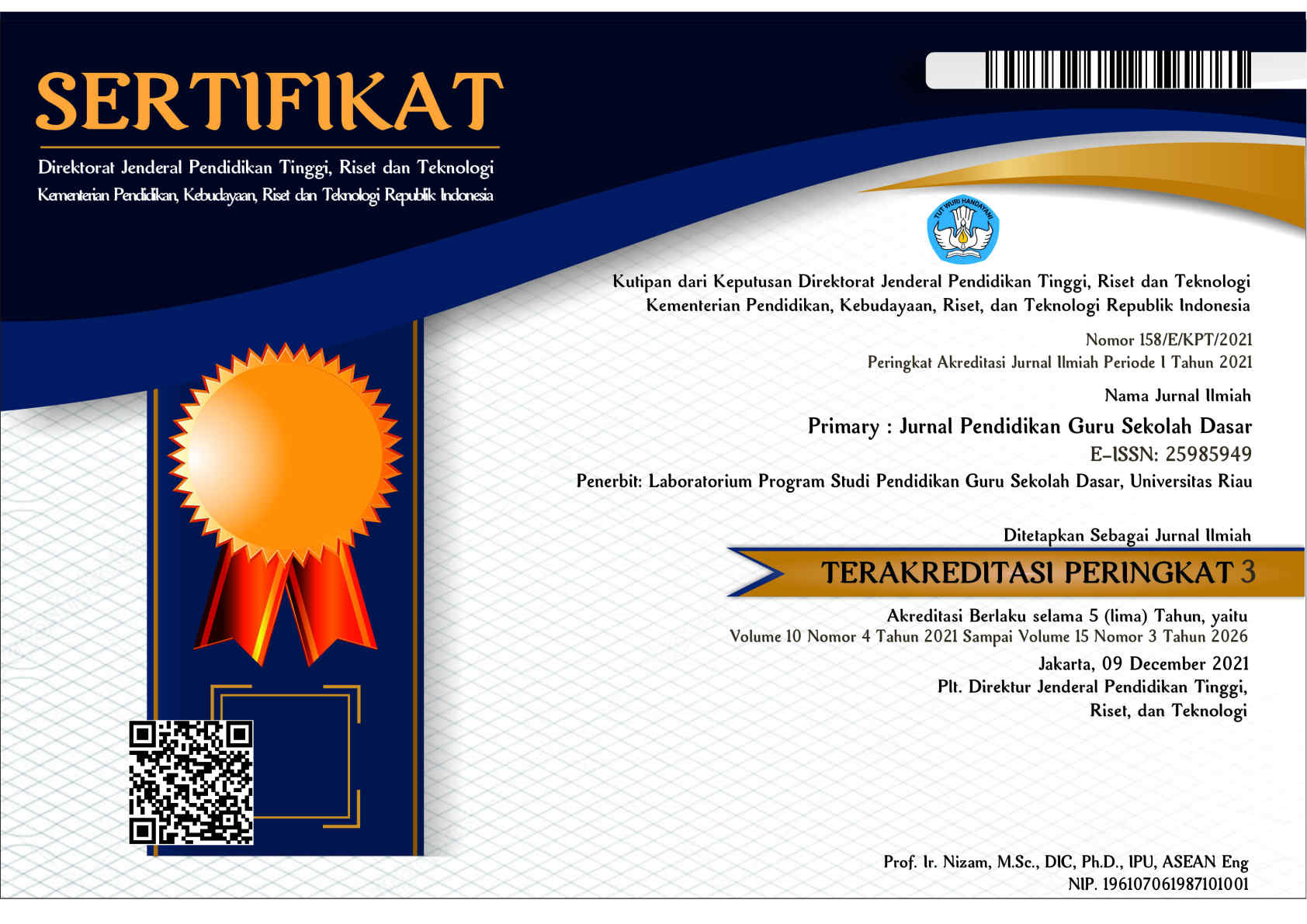THE EFFECTIVENESS OF USING DESIGNED COASTAL AREA MEDIA FOR MATHEMATICS LEARNING
Abstract
The meaning of numbers, often referred to as Number Sense, is very important for students to understand especially in the elementary school. Correspondingly, elementary school students who are new to numbers must be given a real experience as a means of building an understanding of the meaning of numbers. Related to that, this study aimed to investigate the understanding of elementary school students at grade I who were taught with the designed coastal area media. The subjects of this study inclluded 2 elementary schools with a total of 42 subjects located on the coast. The purpose of this study was to investigate the effectiveness of learning and its impact on number sense. The results of the data analysis showed that the effectiveness of using designed coastal area media for mathematics learning was in Good category. Moreover, the students' understanding of the meaning of numbers after the treatment significantly increased by 21.3%.
Keywords
Full Text:
PDF (English)References
Annisa, A. K. (2019) Efektifitas Media Pembelajaran Matematika Menggunakan Software Animasi Berbasis Multimedia Interaktif Model Tutorial Pada Materi Garis Dan Sudut Untuk Siswa Smp/Mts Kelas VII. Jurnal Penelitian Pembelajaran Matematika Sekolah (JP2MS), 1(1). 147-155.
Aperapar, P.S., dan Hoon, T. S. 2011. An Analysis of Number Sense and Mental Computation in the Learning of Mathematics. Jurnal Pengajaran MIPA16 (1), 148-154.
Kurikulum 2013 Lebih Unggul dari Kurikulum Sebelumnya, (Online), (http://www.kaltimpost.co.id/berita/detail/19889/kurikulum-2013-lebih-unggul-daripada-kurikulum-sebelumnya.html), diakses 16 September 2013.
Ma’rifatul, U., dkk (2017). Fefektivitas Pembelajaran Discovery Learning Dengan Media Komik Pada Pembelajaran Garis Dan Sudut Di Smp Negeri 7 Surabaya. Jurnal Matematika dan Pendidikan Matematika, 4(1). 75-80.
Gravemeijer, K.P.E. (1994). Developing Realistic Mathematics Education. Utrecht: CD-b Press. The Netherlands.
Hamzah. (2011). Belajar Dengan Pendekatan PAILKEM. Jakarta: Bumi Aksara.
Hendriani. (2004). Penggunaan Lingkungan Sebagai Sumber Belajar. Depdiknas: PPPG IPA.
Hudoyo, H. (1998). Pembelajaran Matematika Menurut Pandangan Konstruktivistik. Makalah disajikan pada Seminar Nasional Upaya-upaya Meningkatkan Peran Pendidikan dalam Era Globalisasi. PPS IKIP Malang. Malang, 4 April 1998.
Reys, R., Reys, B., Emanuelsson, G., Johansson, B., McIntosh, A., & Yang, D. C. (1999). Assessing number sense of students in australia, sweden, taiwan, and the united states. School Science and Mathematics, 99(2), 61-70. http://dx.doi.org/10.1111/j.1949-8594.1999.tb17449.x
Rey,s, R.E. (1998). Helping Children Lear Mathematics. (5th ed). USA: Ally and Bacon.
Tuckman, Bruce W. (1978). Conducting Education Research. San Diego: Harcourt Brace Jovanovich.
Thiagarajan, Sivasailam; Sammel, Dorothy S; Melvyn L. (1989). Instruction Development For Trining Teachers of Exeptionan Children. Minnessota : Indiana University.
DOI: http://dx.doi.org/10.33578/jpfkip.v9i6.8022
Refbacks
- There are currently no refbacks.
Copyright (c) 2020 Zuhri D, Sehatta Sehatta

This work is licensed under a Creative Commons Attribution-NonCommercial-ShareAlike 4.0 International License.
____________________________________________________________
Primary: Jurnal Pendidikan Guru Sekolah Dasar
Secretariat
Program Studi Pendidikan Guru Sekolah Dasar
Gedung B1, FKIP Universitas Riau
Kampus Bina Widya Km. 12,5 Simpang Baru Panam
Pekanbaru Riau Indonesia 28293
e-mail : primary@ejournal.unri.ac.id



